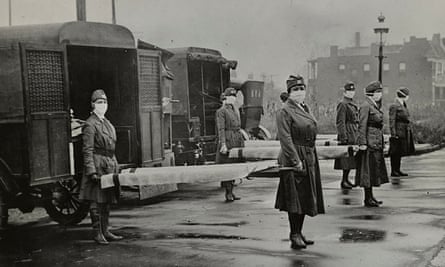Letting the virus that causes Covid-19 circulate more-or-less freely is dangerous not only because it risks overwhelming hospitals and so endangering lives unnecessarily, but also because it could delay the evolution of the virus to a more benign form and potentially even make it more lethal.
Though the data is still sketchy and the measures crude, this effect may already be influencing the difference in death rates between Sweden – which took a relaxed approach to containment until recently – and Norway, whose measures have been much stricter. Sweden has more than three times as many deaths per 100 cases as its neighbour.
The explanation for this startling gap may lie partly in natural selection, and the biological arms race between a pathogen and its host. Within any population, there is genetic variation. Viruses are no different. Some versions of the virus will be very slightly more dangerous to human health – more virulent – others less so. If the conditions are right, the slightly more virulent ones will begin to predominate and cause more damage.
According to this interpretation of the Sweden-Norway discrepancy, it’s not that Sweden has one version of the virus, and Norway another. It’s just that in Sweden conditions have allowed those slightly more virulent variants that already exist in the virus population to flourish. If you want a truly spectacular – if extreme – example of the same mechanism at work, look at the 1918 flu pandemic.
That pandemic killed at least 50 million people, the vast majority of whom died in the second wave – in a mere 13 weeks between September and December 1918 – and though data was even sketchier then, it is considered to have been at least 25 times more lethal than any other flu pandemic in history. The fact that it was so exceptional demands an explanation, and evolutionary biologists have furnished one in the exceptional conditions that prevailed on the western front that summer.
Before I get to that, though, let me take a step back. A pathogen, or disease-causing organism, does not “want” to kill its host. Its only evolutionary goal is to survive and reproduce, and if it has to kill to achieve that aim, then so be it. It causes harm because it needs its host’s cellular machinery to replicate and transmit to a new host. We feel sick because it’s siphoning off our bodily resources, and because of our own immune response.
When a novel pathogen emerges in humans, having jumped from an animal reservoir, it is not adapted to us. If it is too virulent, it risks immobilising its host through illness or death before it can spread to a new one; not virulent enough, and it’s a weak transmitter – another evolutionary dead end. Scientists have recently demonstrated that a successful pathogen is one that evolves to an intermediate level of virulence, so that it can spread without causing too much damage.
Humans shape that process, because we also adapt to the pathogen. We put roadblocks in its way – in the form of containment measures, vaccines and, eventually, herd immunity. Though host and pathogen are endlessly adjusting to each other, a highly virulent, novel virus that encounters these roadblocks will evolve to become less virulent faster, so that it doesn’t die out before it finds susceptible new hosts.
Back to 1918. The first wave of the pandemic, in the northern hemisphere spring of that year, resembled an ordinary seasonal flu, but when the second wave erupted in August the disease was hardly recognisable. Now its victims were turning blue and suffocating as their lungs filled with fluid. What happened to make that flu virus so much more virulent?
Evolutionary biologist Paul Ewald, of the University of Louisville in Kentucky, has pointed to to the close proximity of the men in the trenches, and to the fact that – far from being immobilised – the sick were transported into successive pools of susceptible hosts, from trench to tent to train, and onwards through a series of hospitals.

The tragedy of that situation, in other words, is that humans did the virus’s work for it. It had no need to dial down its virulence to keep spreading – in fact it was in its evolutionary interests to dial it up and transmit even faster, since there was no cost to doing so. From the trenches of Flanders, largely through troop movements, the lethal bug was transported all over the world, where it did so much damage before eventually finding its equilibrium with humanity – much later than it would otherwise have done. That pandemic strain circulated in the world, in modified, milder forms, until 1957 – when it was ousted by the one that caused the next flu pandemic, the so-called Asian flu.
Viruses have another trick up their metaphorical sleeves. Some of them can survive temporarily outside a living host – on doorknobs and keyboards, for example. This alters the rules of engagement in the arms race, by making them less dependent on their hosts to spread, and it helps determine the level of virulence to which the virus eventually gravitates. The virus that causes Covid-19, Sars-CoV-2, is about as durable as the flu virus on surfaces and in the air, which leads Ewald to suspect that it’s heading for a level of virulence comparable to that of seasonal flu. Seasonal flu causes one death per 1,000 infected people, on average. Sars-CoV-2 is killing at roughly 10 times that rate at the moment.
It’s too early to interpret the data on Covid-19, in part because nobody knows how many people have been infected – and there are many other factors in the mix, such as the changing age profile of the patient population and improvements in care – but we may already be seeing viral evolution in tumbling death rates. As epidemiologist Andrew Noymer of the University of California, Irvine, has pointed out, this would happen anyway, in time. But here’s the thing: we can accelerate it, if we choose to. We probably already are, in some parts of the world.
“If we invest in measures like quarantine then we are favouring viral strains that are so mild people don’t know they’re sick,” says Ewald. His colleague at the University of Louisville, biologist Holly Swain Ewald, has argued that such measures are key drivers of the reduction in virulence. If so, then they have probably contributed to the different death rates in Norway and Sweden. Protecting people through public health measures also buys us time, putting off the moment when many people catch the disease until it is much milder. That could make a huge difference to all those people in the world who don’t have access to adequate healthcare.
The ball is in our court, to a large extent. We have a say in how long this pandemic lasts, and how many people die. That’s been said before, but here’s the evolutionary argument for it. The key thing to understand is that we are not passive bystanders; we form the virus just as it forms us. Eventually, Covid-19 will be no worse than flu, or perhaps even the common cold that is caused by one of its relatives. Let’s get there as fast as we can.
• Laura Spinney is a science journalist and author of Pale Rider: The Spanish Flu of 1918 and How it Changed the World








